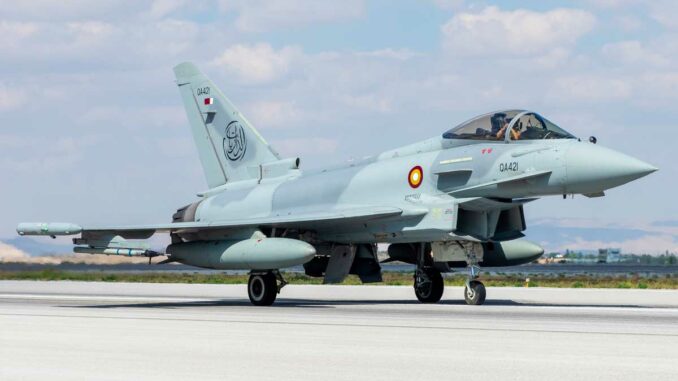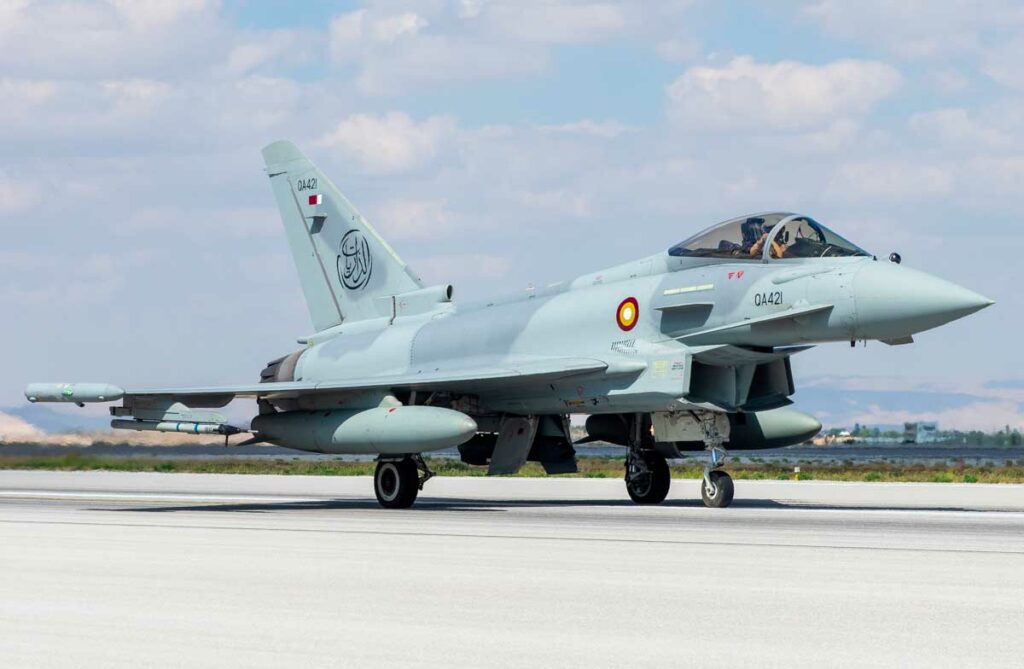
Turkey is negotiating the purchase of 40 Eurofighter Typhoons from the European consortium, including 12 second-hand aircraft, to fill the gap left by the F-35 programme.
Summary
Ankara is moving forward with the acquisition of 40 Eurofighter Typhoons, divided into 12 second-hand aircraft (targeted sources: Qatar and Oman) for rapid commissioning, and 28 new aircraft to be delivered in stages. Consultations are taking place in mid-late October during President Recep Tayyip Erdogan’s visits to Doha and Muscat, ahead of talks with British and German leaders. The Eurofighter consortium (United Kingdom, Germany, Italy, Spain) is sending positive signals, paving the way for an agreement by the end of the year. Turkey’s objective is clear: to fill the capability gap created by its exclusion from the F-35 programme, stabilise its fleet in the face of Greek Rafale and F-35s, and secure an industrial transition to the national Kaan fighter. In terms of budget, a reasonable range places the total cost of the operation between €3.5 and €5.0 billion, depending on the mix of tranches, AESA radar options and armaments (Meteor/Brimstone/Storm Shadow). The European industrial gain is tangible, as is the political effect within NATO.
The framework of the deal: visits to the Gulf to speed up availability
The diplomatic sequence is structured around two axes. First, the short term: acquiring a batch of used Eurofighters already in service in Qatar and Oman, in order to provide the Türk Hava Kuvvetleri with airframes that can be transferred immediately after overhaul (typically 6 to 12 months depending on configuration). Second, the medium term: securing 28 new aircraft from the consortium, with a schedule compatible with production line capacities in the United Kingdom and Italy, and German export authorisations.
This ‘12 + 28’ approach responds to an operational constraint. Turkey must maintain high availability in the Aegean-Mediterranean arc and the Black Sea, while the F-16s are subject to increased wear and tear. An initial batch of second-hand aircraft will cover the immediate need for air policing, interception and air superiority, while new production is being prepared for 2027-2030. Talks with London and Berlin remain crucial: German approval is the regulatory key, while the British integrator is the industrial axis. Parallel discussions with Rome and Madrid are consolidating the supply chain and sub-assemblies (airframe, avionics, armament).
Capability: a Typhoon adapted to Turkey’s posture
The Eurofighter Typhoon fulfils three core missions for Ankara: interception, air superiority, and limited stand-off strike. The airframes of tranches 3/4 with CAPTOR-E AESA radar offer good detection of weak targets at medium range, increased resistance to jamming and better reliability in multi-track tracking. In terms of armament, the integration of the Meteor (range >100 km), the ASRAAM/IRIS-T for close-range combat, and air-to-ground munitions (Paveway IV, SPEAR, Brimstone, Storm Shadow) provides a balanced range for air defence and selective strikes.
In the case of second-hand aircraft, the Qatari (equipped with recent avionics) and Omani (high standard, small fleet) airframes are credible bases. The question is upgrading: switching to CAPTOR-E if absent, reconfiguring data links, harmonising IFF, integrating Turkish weapons (SOM) and targeting pods. On the support side, the logistical footprint (EJ200 engines, rotable parts, test benches) must be financed to avoid the ‘cannibalisation’ effect. Ankara is accustomed to this type of ramp-up: the F-16 programmes demonstrate mastery of MRO and national weapons integration.

The budget: cost assumptions and variables
Without a signed contract, we are working with ranges. For 28 new Tranche 3/4 aircraft with AESA radar, equipment, documentation, initial training and parts, a unit cost of ‘flyaway + kits’ between €100 and €130 million is plausible. This puts the new subtotal between €2.8 and €3.6 billion. For 12 used aircraft, depending on airframe hours, avionics standard and modernisation packages, a budget of €35 to €60 million per aircraft is realistic, i.e. €420 to €720 million. Adding a first weapons package (Meteor/ASRAAM/Brimstone/Storm Shadow) of €400 to €700 million depending on volumes, plus MCO initialisation (tools, stocks, documentation) of €200 to €350 million, we arrive at a total of €3.5 to €5.0 billion.
Two factors shift the needle. First, the systematic CAPTOR-E option on second-hand aircraft increases the bill by tens of millions per cell (kits + labour). Secondly, the partial localisation of heavy maintenance and the integration of Turkish ammunition (SOM, HGK, KGK) can optimise the total cost of ownership. Conversely, licensing delays or excessive customisation increase the overall cost.
The strategic rationale: filling the F-35 gap, containing the Aegean arc, getting through the Kaan phase
Three reasons underpin the decision. First, exclusion from the F-35 programme has created a gap in modernisation. The Typhoon fills this gap in air-to-air capability and stabilises regional deterrence. Second, competition with Athens is intensifying: Greece is fielding Rafale F3R/F4 aircraft and has paved the way for the F-35. Ankara cannot remain with the F-16 alone, even with Block 70 Viper kits. Thirdly, the transition to the Kaan (initially limited production, gradually ramping up) requires capability assurance. The Typhoon is becoming the mainstay of air power for the decade, with acceptable compatibility with NATO networks.
The dimension of cooperation must also be added. London and Berlin are seeking to support a European industrial base that needs production runs and export contracts to maintain skills and supply chains. Rome and Madrid share this interest. For Ankara, this is an opportunity to rebuild political ties with Europe on a concrete project and to diversify its dependencies beyond the United States, without giving up on modernising its F-16s.
The European industrial impact: workload, skills and arms supply chains
The project has a direct impact on the industrial base. In the United Kingdom and Italy, the Typhoon production workload is continuing, which secures critical skills (airframe, AESA radar integration, testing). In Germany and Spain, the flow of sub-assemblies and avionics will continue. European armaments will also benefit: Meteor (MBDA), Brimstone, SPEAR, Paveway IV, and potentially Storm Shadow. Beyond the aircraft itself, the maintenance ecosystem, simulators, test benches, and training are all running smoothly, with SMEs benefiting from the supply chains (composites, electronics, hydraulics).
Politically, Germany’s approval breaks a recurring barrier on licences and signals a more pragmatic stance from Berlin on defence exports to a NATO ally. For London, it is a success for industrial diplomacy and a sign of post-Brexit credibility in European aeronautical cooperation. Rome and Madrid are consolidating their role in a major programme while awaiting the milestones of GCAP/FCAS on the next generation.
NATO implications: interoperability, burden sharing and deterrence posture
For NATO, the arrival of 40 Turkish Eurofighters improves air-to-air interoperability, access to the common data link, and burden sharing in air policing missions in the Black Sea and eastern Mediterranean. The Typhoons, equipped with AESA and Meteor, expand the air deterrence bubble, particularly against slow/low/small threat profiles and older platforms. Turkish detachments can relieve allied rotations, reduce pressure on the Baltic and Balkan fleets, and offer long-range escort and interception options.
There is also a doctrinal dimension. Turkey will be able to capitalise on British and Italian experience with Typhoon QRA, standardise its procedures, and then transfer some of these standards to the Kaan. For the Alliance, this ensures that Ankara remains anchored to Western standards for sensors, weapons and C2, despite national industrial diversification.
Risks and conditions for success: licences, timetable and MCO
Three risks must be managed without delay. Firstly, the licence timetable: German approval must be translated into concrete authorisations, line by line, to avoid ‘micro-blockages’ on sensitive sub-assemblies. Secondly, fleet consistency: mixing used and new equipment requires a clear standardisation plan (software, sensors, weapons) to avoid costly micro-fleets. Thirdly, MCO: without a multi-year contract for parts, tools and software updates, the operational advantage is diluted by unavailability.
On the Turkish side, a 36-month integration plan, with milestones for each squadron, is the only way to deliver on the promise of availability. On the European side, tighter industrial governance (BAE Systems, Airbus, Leonardo, MBDA) and a single export window will avoid friction between nationalities. Without these safeguards, the deal will quickly turn into a compilation of announcements.
Outlook: towards an agreement by the end of the year, subject to final decisions
The political window is favourable. If Ankara obtains 12 second-hand aircraft for 2026 and secures 28 new aircraft in production, the Turkish Air Force will have a credible stepping stone before the arrival of the Kaan. The Europeans, for their part, are securing orders and arms flows. All that remains is to decide on the basket of options: systematic AESA radar, sufficient volume of Meteor, intelligent air-to-ground capabilities and compatibility with Turkish architecture. This is where the difference between a simple acquisition and a capability leap will be played out.
Regionally, Athens, Cairo and Jerusalem will be watching the balance. A disciplined Turkish build-up, anchored to NATO, stabilises rather than destabilises. Conversely, a mix of offensive weapons without political safeguards is creating tension in the Aegean-Levant arc. Future communiqués will reveal whether this issue becomes a textbook case of Euro-Turkish realignment through industry, or yet another saga of extended licences.
War Wings Daily is an independant magazine.